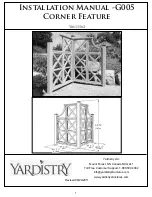
3- 2
85058V
Use, Maintenance, and Care of the Devices
Electrostatic Discharge
Electrostatic Discharge
Protection against electrostatic discharge (ESD) is essential while connecting, inspecting, or
cleaning connectors attached to a static-sensitive circuit (such as those found in test sets).
Static electricity can build up on your body and can easily damage sensitive internal circuit
elements when discharged. Static discharges too small to be felt can cause permanent
damage. Devices such as calibration components and devices under test (DUT), can also carry
an electrostatic charge. To prevent damage to the test set, components, and devices:
•
always
wear a grounded wrist strap having a 1 M
resistor in series with it when handling
components and devices or when making connections to the test set.
•
always
use a grounded, conductive table mat while making connections.
•
always
wear a heel strap when working in an area with a conductive floor. If you are
uncertain about the conductivity of your floor, wear a heel strap.
•
always
ground yourself before you clean, inspect, or make a connection to a static-sensitive
device or test port. You can, for example, grasp the grounded outer shell of the test port or
cable connector briefly.
•
always
ground the center conductor of a test cable before making a connection to the
analyzer test port or other static-sensitive device. This can be done as follows:
1. Connect a short (from your calibration kit) to one end of the cable to short the center
conductor to the outer conductor.
2. While wearing a grounded wrist strap, grasp the outer shell of the cable connector.
3. Connect the other end of the cable to the test port.
4. Remove the short from the cable.
shows a typical ESD protection setup using a grounded mat an wrist strap. Refer to
for information on ordering supplies for ESD protection.
Figure 3-1 ESD Protection Setup
Summary of Contents for 85058V
Page 1: ...Keysight Technologies 85058V 1 85 mm Verification Kit User s and Service Guide...
Page 2: ......
Page 3: ...85058V...
Page 7: ...1 General Information...
Page 12: ...1 6 85058V General Information Clarifying the Terminology of a Connector Interface...
Page 13: ...2 Specifications...
Page 20: ...2 8 85058V Specifications Electrical Specifications...
Page 21: ...3 Use Maintenance and Care of the Devices...
Page 36: ...3 16 85058V Use Maintenance and Care of the Devices Handling and Storage...
Page 37: ...4 Performance Verification...
Page 40: ...4 4 85058V Performance Verification Recertification...
Page 41: ...5 Troubleshooting...
Page 43: ...85058V 5 3 Troubleshooting Troubleshooting Process Figure 5 1 Troubleshooting Flowchart...
Page 47: ...6 Replaceable Parts...
Page 54: ...6 8 85058V Replaceable Parts Replaceable Parts...
















































